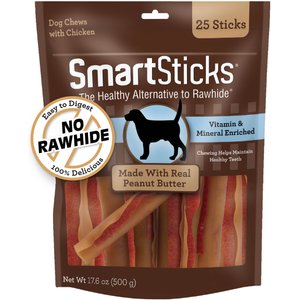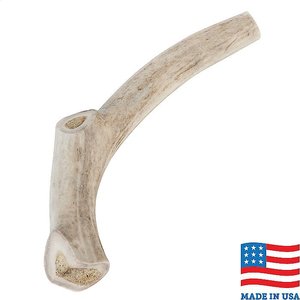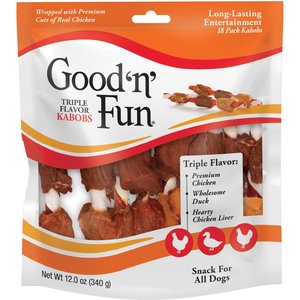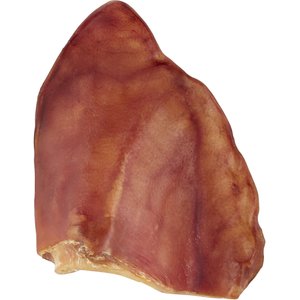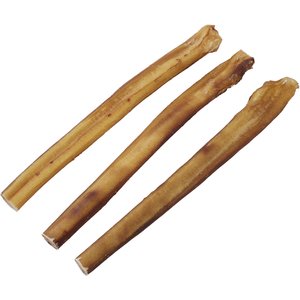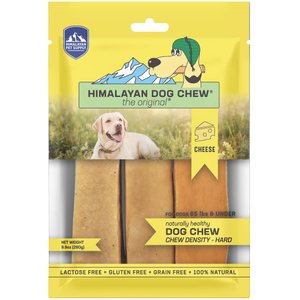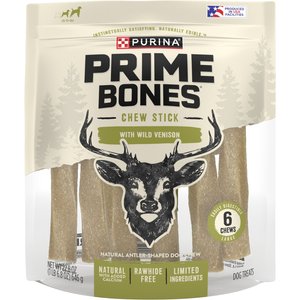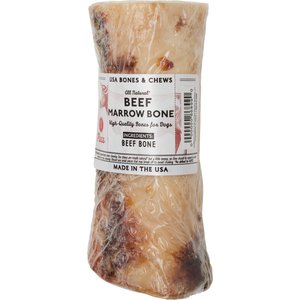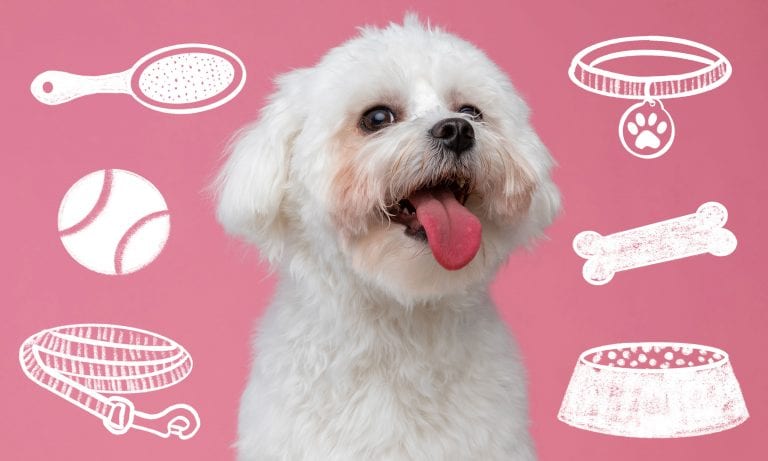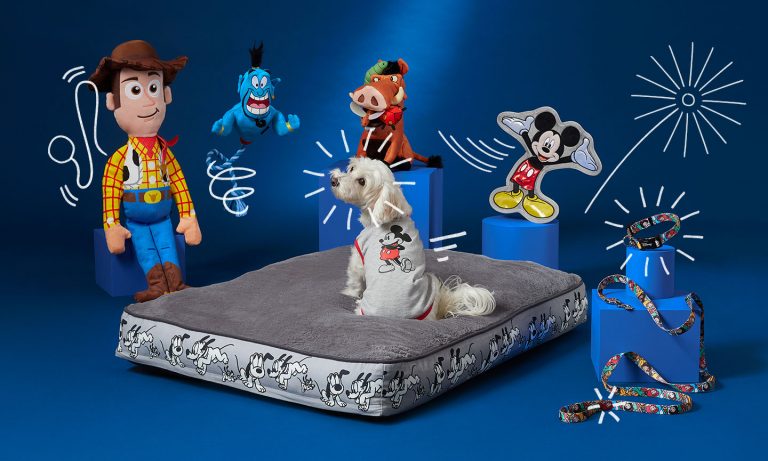If you’re a dog, there’s nothing like a good chew session to relax, unwind and get in touch with your inner canine self. Chewing is a natural behavior for dogs, a beloved pastime that helps them explore the environment around them, alleviate anxiety and boredom, strengthen their jaws and even clean their teeth. (Plus, it’s just plain fun!)
In the wild, dogs and wolves gnaw on animal bones. But at home, there are safer (and less messy) options. Ready to treat your best friend’s chompers to a toothsome treat? Read on for everything you need to know about the best long-lasting dog chews, including expert veterinarian advice and product recommendations from pet parents like you.
-
1
Best Overall Long-Lasting Dog ChewSmartBones SmartSticks Peanut Butter Dog Treats, 25 count $14 on Chewy
- 2
- 3
- 4
- 5
How To Find the Longest Lasting Chews for Dogs
Chews offer many health benefits, but it’s important to select the correct product for your individual pup.
“While practicing, I’ve undoubtedly seen the benefits chewing can provide dogs, from stimulating their natural foraging instincts to reducing plaque buildup,” says Dr. Sara Ochoa, a veterinarian at Animal Hospital of West Monroe in Louisiana, who holds a dual DVM/PhD in veterinary dentistry. “However, I’ve also treated cases where inappropriate chews sadly resulted in costly dental repairs or even surgical removals of foreign bodies.”
When selecting a chew, consider the following:
- Your veterinarian’s advice: First and foremost, consult with your veterinarian if you have any concerns about your dog’s behavior, current chewing habits or dental health. Your veterinarian will also be able to offer advice on the best chews for your dog.
- Ingredients: Carefully check the ingredients before purchasing a chew, especially if your dog has any food sensitivities or allergies.
- Type of chew: Different types of chews offer different benefits (more on that below!). Before shopping, decide which is best for your dog: antler, rawhide, natural, bully or Himalayan.
- Your dog’s size: Size matters! Small dogs won’t be able to get their jaws around chews that are too big, and tiny chews can be choking hazards for large breeds. Check the manufacturer’s packaging for breed size recommendations.
- Your dog’s health: In addition to food sensitivities, consider your dog’s dental health. If your pet is awaiting dental work, choose a softer chew until their mouth is healed and healthy. Because they often have less jaw strength, puppies and seniors should also opt for softer chews.
9 Best Long-Lasting Dog Chews
We’ve rounded up the best dog chews as tested and approved by Chewy customers. These nine top-selling, top-rated chews get two paws up from dog parents like you.
Best Overall Long-Lasting Dog Chew
-
Great rawhide alternative
I don’t like giving my dogs rawhide but these are the perfect alternative! They love peanut butter and they can chew on these for a long time!
-
Dogs Love These!
Dogs love the taste and they have a wonderful time eating away at them. No mess after they eat, they don’t stain or crumble!
Best Antler Dog Chew
-
How large it was
It’s been nice having one that stands up to his chewing. Most he can get through in a few days.
-
He loves it
Not sure why, he usually don’t like plain things, it usually has to have peanut butter in it or a bulky stick lol but he loves this and will chew on it an hour straight!
-
Good quality
These have always been good for our dogs. Have a Husky and chocolate lab, both like to chew. They love when we hold one end and they lay down by us and chew the other side. Good bonding activity from our personal trainer
Best Rawhide Dog Chew
-
Delicious treat
My dog, Nala, likes these so much. Every night, as long as she eats all her food, she looks for her ‘treat’.
Best Natural Dog Chew
-
a pet favorite.
My dog thoroughly enjoyed this pig ear! He carried it around and just licked it for the first few days. It is now gone and I must say he enjoyed it. I guess I’ll have toremember to buy another one soon.
-
Big pig's ear but not gluttonous
Winnie loved the pig's ear, plopping down immediately to go to crunchy work. And, she still had room for her regular meal. Happy *and* well-fed.
-
pig ear treats
These are a fun treat for our dog who liked to chew. Sometimes she buries them & they soften. Either way, they are thoroughly devoured.
Best Bully Stick
-
great thick option
It can be hard to find truly thick "thick" bully sticks, but this one's a keeper. My dog will work at it for days.
-
Only ones dogs love
I used to buy the Dentley’s version of these but then dentleys quality went down and the bones got skinnier. It became a frustrating waste of money. Then I found these, basically the same bones and I could buy bulk too! My pugs love these and they last a decent amount of time. I will never buy dentleys again and instead buy from chewy.
-
Best Bully sticks by far!
I ordered these ones instead of the usual ones as the other ones were not consistent in sizes in the same bag and some were so thin and flimsy I was afraid my dog would but big chunks off and swallow it BUT these ones are fantastic and consistently substantial. They last much longer too so they’re more cost effective and safe!
Best Himalayan Dog Chew
-
More bang for your buck
I found a similar product in a boutique in NC. It was pricey but I splurged. The savings here are phenomenal and my pooch loves them! Once again a great job by chewy !
-
My dogs love them
My dogs love these! And I love that you can microwave the small pieces to puff them up is great!! I'm ordering more.
-
Dogs LOVED
I have not met a dog who doesn’t love these cheese sticks. They last a long time. They keep dogs entertained and I don’t have to worry about the pups puking after, like other bones. I did have one dog bury his, but all my other fosters LOVED them. From puppy to seniors, you’re dog will thank you for the yummy chew toy!
Best Long-Lasting Chew for Small Dogs
-
The girls love them!
I like the little ones because I can break them in half easily. So I don’t overdo it for the dogs they would eat them all day long!
-
Great flavor
My pup loves these and would eat the whole bag in one day. I have to hide them from him.
Best Long-Lasting Chew for Large Dogs
-
wanting to trial a different ingredient
All my dogs love these! The good chewers devour in short order. So I use them to say "stay calm while I'm away and keep the house safe". I did discover that my border collie who isn't a big chewer and doesn't like anything hard or rough like rawhide or coffee wood. These ended up being the right consistency and hardness and taste I presume, and have a smooth surface. This is the only chew bone that she enjoys chewing on. Right now we are waiting for this product to become available again. Ho Hum.......
-
My dog loves these
I wish i knew why these were discontinued my dog loves them and is disappointed he cant have them anymore
-
My dog's favorite treat
As soon as I take one out of the package, she starts spinning and jumping. Once I give it to her, she runs around tossing it to herself before finally settling down to eat it. It is a special treat that she loves.
Best Long-Lasting Bone Chew
-
Good size for the price
My fur baby enjoys chewing and having q bone he enjoys chewing on definitely saves him from chewing up his toys i recommend this bone.
-
Good raw chew bone for large dogs
My english labrador loves these bones. There's not too much coating on it and there's plenty of marrow to keep her busy & satisfied.
-
Cookie's tired
Cookie chess and chess on her bone until she is exhausted and falls asleep. Guess you know she loves it.
Types of Long-Lasting Dog Chews
There are a number of types of dog chews, each with their own unique benefits.
Antler
Antlers used for dog chews come from a variety of sources, including deer, elk and moose. They naturally vary in size, texture and shape, making them a good choice for a wide range of pups. Antlers contain many vitamins and minerals and splinter less easily than bone.
Best for: dogs who do best with limited-ingredient diets; pet parents interested in natural treats
Rawhide Chew
Rawhide chews are made from the inner layer of cow or horse hides and may contain flavorings. Some rawhide products break down more quickly than others. Because rawhide is not easily digestible, discard any smaller pieces. It’s usually not recommended for strong chewers.
Best for: puppies, seniors and other dogs, who don’t have a strong bite or aggressive chewing habits
Natural Chew
Natural dog chews are single-ingredient products sourced from a variety of protein sources, including pork, beef and venison. Natural chews are made from body parts such as ears, bones and tendons, which have been dried and dehydrated.
Best for: dogs who do best with single-ingredient treats; ingredient-conscious pet parents
Bully Stick
Bully sticks are made from pizzle (also known as bull penis), a high-protein, highly digestible beef muscle not typically processed for human consumption. Once dehydrated, the muscles are shaped into a variety of sizes and shapes, making them appropriate for many dog breeds and ages.
Best for: dogs who easily tolerate beef; pet parents interested in single-ingredient treats
Himalayan Chew
Also known as “yak chews,” Himalayan chews are made from yak and cow milk, along with salt and lime juice or vinegar. After boiling, the curds are shaped into chews and dried. The resulting hard, cheese-like product takes a long time to break down and makes for an enticing treat.
Best for: dogs who tolerate dairy
Note: When searching for dog chews, you’ll probably come across nylon chew toys. While they tend to be more durable than natural bones and often feature textured surfaces to clean teeth, they’re usually inedible—meant more for encouraging chewing than actually eating.
Dog Chew Safety Tips
It’s important to offer your pup plenty of opportunities to gnash and gnaw. However, safety comes first! Consider the following tips from Dr. Ochoa:
- Harder isn’t always better. Many pet parents make the understandable mistake of selecting chews that are too hard. While extra-hard chews are less likely to splinter apart and may last longer, they can also damage teeth that aren’t up to the task. In general, a chew should give slightly when you press your nail into it; however, some dogs—including puppies, seniors, and those experiencing dental issues—may need a softer option. “It’s vital to match the chew to each dog’s needs, from young puppies to senior pets,” says Dr. Ochoa. “Hard chews could crack teeth in unintended ways.”
- Mix it up. Different shaped chews work different parts of the mouth. For example, a dental chew targets the teeth and gumline, while a bully stick is more about jaw work. Offer your pup a variety of options to prevent over-stimulating one area. “To best promote dental health without hazard, I suggest rotating between chew varieties,” says Dr. Ochoa.
- Avoid artificial ingredients. When possible, choose a chew with the cleanest and least amount of ingredients, avoiding dyes and preservatives, advises Dr. Ochoa.
- Supervision, supervision, supervision. Avoid giving your pup a chew treat and walking away, especially if you’re trying a product for the first time, says Dr. Ochoa. “Supervision remains key, since some chews could present choking issues in the wrong situation.”
Long-Lasting Dog Chews FAQ
Q: Why do dogs chew?
A: Chewing is a natural instinct for dogs. It allows them to explore the world around them, providing both important information and exciting enrichment.
Q: Is chewing good for dogs?
A: Chewing offers a variety of health benefits for dogs. Chewing helps puppies relieve teething pain and allows older dogs to maintain jaw strength while cleaning their teeth. Chewing also provides mental stimulation, prevents boredom and can help relieve anxiety.
Q: Can I give my dog a chew every day?
A: Chews can be an appropriate daily treat for some dogs, but it’s important to rotate between chew varieties to avoid dental damage. Different chews work different areas of the jaw and teeth, and you don’t want to overdo it in any one spot for too long, which could cause damage. Additionally, be mindful of how many calories are in the chews; treats should make up no more than 10% of your dog’s daily caloric intake.
Q: How long should my dog have a chew for?
A: Every dog and chew is different. However, as a general rule, a 10-15 minute gnawing session should be enough to satisfy your pup, and any longer could result in tooth or gum damage.
Q: What size chew should I give my dog?
A: Chews that are too small for your pup can pose a choking hazard, so take the size of your pet’s mouth into consideration. If your dog can fit the entire chew in their mouth at once, it’s too small and you’ll want to size up to something larger.
Q: Can puppies have dog chews?
A: Chews are great at providing entertainment for puppies, as well as relief from teething. Puppies should be given softer chews than adult dogs, and, as with dogs of any age, should always be supervised. Wait until your puppy is at least 8-weeks old to introduce chews.
How We Chose These Products
Chewing is an important part of being a dog, offering both physical and mental benefits. Failing to offer quality chewing opportunities can negatively impact your pup’s health (as well as your couch cushions!). That’s why we rounded up these best-of-the-best products, as chosen by satisfied Chewy customers. Backed by hundreds of reviews and ratings (4 stars and more), these top-rated bestsellers have proven to be engaging and long-lasting tools in keeping dogs healthy and happy.
Talk to Your Veterinarian
Chews should not be a substitute for regular dental care and should be used in addition to mentally engaging activities such as training, play sessions, walks and exercise. Before introducing a new chew into your dog’s routine, consult your veterinarian and address any concerns about your dog’s dental health or behavior. Never leave your dog alone with a chew to prevent any possibility of choking.
“With guidance, chews offer enormous mental stimulation alongside their dental benefits. Chews done right absolutely have their place for most canine companions,” says Dr. Ochoa. “But as with any new item, consulting your vet ensures safe enjoyment tailored perfectly to Fido.”
Next Steps for Dog Chew Success
Chews are an easy, fun way to help keep your dog’s brain busy and chompers clean! However, just like us humans, dogs require regular dental care to maintain their teeth and oral health. For more ways to keep your pup’s pearly whites gleaming, check out these dental care tips for dogs.
Expert input provided by Dr. Sara Ochoa, a veterinarian at Animal Hospital of West Monroe in Louisiana, who holds a dual DVM/PhD in veterinary dentistry.
Learn more about dog chewing:
Share:

